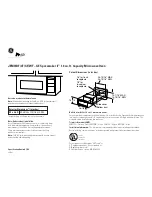
39
Cooking Guide
Microwave Recipe Preparation and Techniques
Plan your meals so that the food will not all need last minute
cooking or attention at the same time. The special features of
microwave cookery make it easy to serve meals with everything
piping hot. Cooking of some foods may be interrupted while you
start others, without harming the nutritional value or flavour of
either. A recipe which requires standing time can be microwaved
first and another food cooked while it stands. Dishes prepared in
advance can be reheated briefly before serving. It does take
some experience and time to cook with confidence. Microwaves
are fast so you will have to do some experimenting. You might
find you will use your conventional range in conjunction with your
microwave oven. For example, while cooking the roast in the
microwave oven, you can be cooking the vegetables and gravy
on the range top. This can also be done the other way around.
Prepare your meal as follows.
1. Firstly, cook the most dense item (roast or
casserole). Drain and retain meat juice from joints
then cover with foil.
2. Cook the potatoes, rice or pasta.
3. Cover with foil for standing.
4. Cook greens and other vegetables.
5. Cover with foil for standing.
6. Cook the gravy with the retained meat juices,
stock and thickening
7. Carve the roast and serve the vegetables and
gravy.
While you are learning to plan meals, you may get a bit behind
time. Don't worry. Dinner servings may be suitably reheated on
MED HIGH, at 2 minutes per serving.
If you prefer not to use foil, cover food with saucepan lids. A metal
lid will retain the heat for at least 15 minutes.
Meanwhile, how can you cook all the vegetables at the same
time? Simply place potatoes and pumpkin in one dish and less
dense vegetables such as broccoli, cabbage, cauliflower, beans
and peas in another. Sprinkle greens with water. Cover with a lid
or plastic wrap. Cook on HIGH for approximately 10 to 15 minutes
for a serving for four people. Remember, if you increase the
quantity of vegetables, increase the cooking time. Fresh and
frozen vegetables can be mixed on a vegetable platter, but
remember the latter are not as dense as fresh vegetables, as they
have been blanched before freezing. If vegetables are cut to a
similar size to each other, they can be cooked in separate
ramekins or small dishes at the same time.
• To blanch (1 cup) nuts, place in a pie plate. Cover with hot tap
water and heat on HIGH for 2 to 3 minutes. Rinse in cold water
and rub between sheets of paper towel to remove skins.
• To toast coconut, place half a cup on a paper towel, and cook
on HIGH for 1 to 2 minutes, stirring occasionally.
• To make buttered breadcrumbs, combine 1 cup breadcrumbs
and 2 tablespoons butter and heat on HIGH for 1 to 2 minutes,
stirring occasionally.
• When heating 100 g baby food, select HIGH for 15 to 30
seconds, depending on the amount of food or liquid and the
starting temperature of it. Test temperature before serving or
further heating.
• For an added touch at dinner parties, steam your own hand
towels. Saturate in cold water, wring and place on a plate. Heat
on HIGH for 1 to 2 minutes.
• To soften cream cheese or butter, place in oven on LOW for
1/
2
to 1 minutes per
1/
2
cup.
• Refrigerated cheese (250 g) can be heated to room temperature
on MEDIUM for 1/2 to 1 minute, depending on size.
• When having a barbecue, partially cook food in the microwave,
season and finish cooking on the barbecue.
• To melt chocolate, place 100 g broken chocolate in a 4 cup
glass jug and heat on MEDIUM for 2 to 3 minutes. As chocolate
holds its shape after heating, stir and stand before adding extra
time to cooking.
• To remove oven odours, combine
1/
2
teaspoon vanilla essence
with 1 cup water in a small bowl and heat on HIGH 4 to 5
minutes. Wipe oven interior with a damp cloth.
• To toast 1 cup almonds place onto a plate and heat on HIGH for
2 to 3 minutes, stirring every minute.
• To dry herbs, arrange
1/
2
cup of leaves evenly on paper towel.
Place a mug of water into the oven next to the herbs and cook
on HIGH for 1 to 3 minutes, or until dry and crumbly. Check
herbs frequently as timing may vary with different herbs. Please
note that herbs dry and crumble on standing outside the
microwave oven.
• To soften dried fruit, place 1 cup of dried fruit into a small bowl.
Add 2 tablespoons of water, cover with plastic wrap and cook on
HIGH for 2 to 3 minutes.
• To skin tomatoes, place 1 cup of hot tap water in a 2 to 3 cup
jug or bowl and heat on HIGH for 1
1/
2
minutes or until boiling.
Add 1 tomato and heat for a further 20 to 30 seconds, remove
and repeat procedure with remaining tomatoes. The skin will
be loosened and easily removed.
• To dry fresh breadcrumbs (1 cup), spread on the base of a plate
and heat on HIGH for 2 to 3 minutes, stirring twice during
heating.
Menu Planning for Microwave Cooking
Handy Hints and Tips
















































